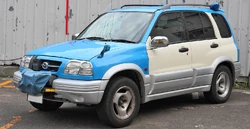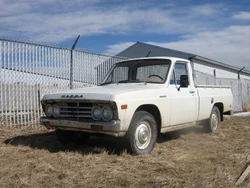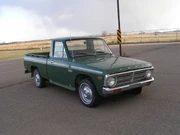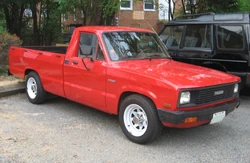- See Ford Ranger (North America) for the North American version sold from 1994.
 | |
| Production | 1961–2006 |
|---|---|
| Successor | Mazda BT-50 |

Mazda Proceed Levante 201
The Mazda B-Series is a pickup truck, first manufactured in 1961 by Mazda Motor Corporation. From the first B-Series, Mazda has used the engine displacement to determine the name. Thus, the B1500 had a 1.5 L engine, and the new B4000 has a 4.0 L V6. In Japan, Mazda used the Proceed name on its compact pickup trucks, and another line of larger trucks is available called the Mazda Titan. Other names used for this line include Mazda Bravo (Australia), Mazda Bounty (New Zealand), Mazda Magnum / Thunder / Fighter (Thailand), and Mazda Drifter (South Africa).
Mazda's partnership with Ford has resulted in the sharing of this vehicle as the Ford Courier, and later as the Ford Ranger. However, it should be kept in mind that the Mazda B-Series and Ford Ranger twins sold in North America are unrelated to the ones sold elsewhere. These are engineered by Mazda, whereas the North American models are developed by Ford.
First generation (1961–1965)[]
| Production | 1961–1965 |
|---|---|
| Assembly | Hiroshima, Japan |
| Body style(s) | 2-door truck |
| Layout | FR layout |
| Engine(s) | 1.5 L I4 |
The Mazda B-Series bonnet truck was introduced in Japan in August 1961 as the B1500. This model was the only JDM model to be badged as itself, i.e. B1500. The BUD61 that followed started the long running name of Proceed in Japan. It had a 1484 cc OHV water-cooled engine with wet sleeve cylinders which produced about 59 hp (44 kW). It had a 1 ton payload. This model also ran a torsion bar front/leaf spring rear type suspension, which was advanced for its time, giving it a relatively smooth ride.
It presaged many of the compact pickups of today.
Second generation (1965–1971)[]
| Also called | Mazda Proceed |
|---|---|
| Production | 1965–1971 |
| Assembly | Hiroshima, Japan |
| Body style(s) | 2-door truck |
| Layout | FR layout |
| Engine(s) | 1.5 L UA I4 |
The 1966 B1500/Proceed continued with the same 1,484 cc OHV I4, with minor changes in the cylinder head/valves and the use of a downdraft carburetor instead of a sidedraft unit as used on the 1961 to 1965 models. The UA engine now produced 73 hp (54 kW). The chassis, now called the BUD61, had a major facelift and changed to four headlights. It looked very similar in appearance to the B1600 that succeeded it in 1971.
Third generation (1971–1979)[]
 | |
| Also called |
Ford Courier Mazda Proceed Rotary Pickup |
|---|---|
| Production | 1971–1979 |
| Assembly | Hiroshima, Japan |
| Body style(s) | 2-door compact |
| Layout | FR layout |
| Engine(s) |
1.6 L NA I4 1.8 L VB I4 1.3 L 13B |
The B-Series was introduced to the United States with the 1972 B1600. It was joined in 1974 by the similar rotary-powered Rotary Pickup. The engine was enlarged to 1.8 L for 1975's B1800. Known in the Japanese market as the Proceed, it was also sold as the Ford Courier.
Engines:
- 1972–1976 – 1.6 L (1,586 cc) NA I4
- 1975–1979 – 1.8 L (1,796 cc) VB I4
- 1974–1977 – 1.3 L (654 cc x 2) 13B
Rotary Pickup[]

Mazda Rotary Pickup
The Rotary Pickup (REPU) was the world's first and only Wankel engined pickup truck. It was sold from 1974 to 1977 and appears to have been available only in the United States and Canada.[1] The Rotary Engined Pickup (REPU) had a 4-port 1.3 L 13B 4-barrel carbureted engine,[2] flared fenders, battery mounted under the bed, a different dash, front grille, and round taillights.
It is estimated that just over 15,000 total units were built. Most were made for the 1974 model year, due to the energy crisis putting a damper on sales, Mazda restamped many of the 1974 models with a prefix "S" designating it as a "1975" model. Approximately 700 units were built for the 1976 model year. Mazda invested in a moderate redesign for the 1977 model, updating electrical systems, adding an additional 4 inches (100 mm) cab stretch for more comfort, and adding a 5-speed manual transmission with different differential gearing. However, after about 3,000 units, the REPU was discontinued due to poor sales.
Road & Track magazine was impressed with the "smooth, quiet power" and the "nice" interior.[3] Price at the time was about US$3500, and observed fuel economy was 16.5 miles per US gallon (14.3 L/100 km/19.8 mpg-imp). Most of the trucks are found on the west coast of the US, and they continue to be sought out by enthusiasts.
Like many of the other Mazda rotary vehicles, the REPU was raced. Its most notable finish was an overall victory at the 1975 SCCA Mojave 24 Hour Rally at the hands of drivers Malcolm Smith and Jack Sreenan.
Ford Courier[]

Ford Courier
The first generation Ford Courier was introduced for the 1972 model year and sold for a little over US$2,000 when introduced—close to the price of an F-100.
The Courier was manufactured by Toyo Kogyo (Mazda),[4] and imported and sold by Ford Motor Company as a response to the unforeseen popularity of the small Toyota and Nissan/Datsun pickups among young buyers in the West. Like the other mini-pickups of the time, it featured a sub-2 liter four cylinder engine, a four speed manual transmission, rear wheel drive, an impressive load capability of 1,400 lb (635 kg) considering its size, and a fairly small price tag compared to full size pickups of the time. To circumvent the 25% Chicken tax on light trucks, Couriers (as with Chevrolet LUV's) were imported in "cab chassis" configurations, which included the entire light truck, less the cargo box or truck bed and were only subject to a 4% tariff.[5] Subsequently, a truck bed would be attached to the chassis and the vehicle could be sold as a light truck.
The body styling was effectively that of the related Mazda B-series, however its frontal treatment was unique, with a grille designed to emulate the larger Ford F-series, and large single headlights, instead of the B-series' smaller twin units.
When the Courier was introduced it came standard with a 1.8 liter overhead cam engine, which produced 74 hp (55 kW) at 5,070 rpm, and 92 lb·ft (125 N·m) at 3,500 rpm. A 4-speed manual transmission was standard, and there was also a 3-speed automatic option (the 5-speed manual option came in 1976).
Badging changed a few times in the first-gen series. In 1972, the tailgate read "FORD COURIER" in large raised letters, with a small "COURIER" badge on the front of the hood (from '73 on through '76 the hood badging read "FORD"). In '73 the tailgate read "COURIER" in large letters, with a small "FORD" badge on the upper left. In '74 it read "FORD" in large letters, with a small "COURIER" badge on the lower right. In 1976 the cab was lengthened 3 inches (76 mm), and the grille received added trim.
Fourth generation (1978–1985)[]
 | |
| Also called |
Ford Courier Mazda Proceed |
|---|---|
| Production | 1978–1985 |
| Assembly |
Japan: Hiroshima, Japan Colombia: Bogota (CCA) |
| Body style(s) | 2-door compact in standard and long bed |
| Layout | FR layout |
| Engine(s) |
2.0 L F/MA I4 2.0 L FE I4 2.2 L S2 diesel I4 |
| Transmission(s) |
5-speed manual 3-speed automatic |
| Related | Ford Courier |
Introduced in 1978, In the U.S. in 1980, the B2000 used a 2.0 liter F/MA engine, replacing the B1800. The diesel 2.2 L B2200 joined this truck in 1982. The US B-Series continued through 1985, one year past the international version, though the 2.0 L engine was updated that year.
The B2000 was also available in a long bed version which was given the model name Sundowner – a reference to nomadic Australian herders who would make camp wherever they were at sundown.
In Australia and New Zealand, the Courier was a compact pick-up built for Ford by Mazda in Japan.[6] It was first offered on the Australian market in 1979.[7]
Engines:
- 1980–1984 – 2.0 L (1,970 cc) F/MA I4
- 1985 – 2.0 L (1,998 cc) FE I4
- 1982–1985 – diesel 2.2 L (2,209 cc) S2 I4, 59 hp (US)
Ford Courier[]

1979 Ford Courier
In 1977 the Courier was redesigned, and a host of new options was available. The truck was available with front disc brakes, as well as a Ford built 2.3 liter engine option (which was the same as that of the Ford Pinto and Mustang II). The key identifying feature of the Courier from Mazda's B-Series was still the singular headlights, although with park and indicator lights placed inset starting in '78 ('77s still had the turn signal lights in the bumper).[8]
In 1979 the base model engine was increased in size to 2.0 liters (120.1 CID). The optional Ford 2.3 L (~140 cu in) engine was produced in Brazil.[8]
The Courier was never available with a diesel engine in the US. However, the 1980 Mazda B2200 was available with the S2, a Perkins-built 4.135 (4 cylinder, 135 CID) 2.2 liter diesel engine, producing 66 hp (49 kW) at 2,100 rpm. This same diesel engine was available in the 1983 and 1984 Ford Ranger, however it was replaced by the Mitsubishi 4D55T 2.3 liter Turbo Diesel (also used in Mitsubishi's own Mighty Max and the Dodge Ram 50) for the 1985 to 1987 Ford Rangers.[8]
| 1984 Ford Courier (facelift, Australia) | |
The Courier continued to be sold in North America until the model year 1982, in which year power steering was added. For 1983, Ford of North America introduced its own Ford Ranger to fill its compact truck segment, which replaced the Courier in the U.S. and Canadian markets.[8]
However, in other markets (such as Australia), this generation of Courier continued on until the 1985 calendar year when the next generation was introduced. Australian models received a facelift around 1982/1983.
Electric variants
Between 1979 and 1982 a number of electric Ford Couriers were produced — Jet Industries purchased "vehicle gliders" (Ford Courier bodies minus their engines), and put in a series DC motor and lead acid batteries, to produce the Jet Industries ElectraVan 750. These were sold mainly for service trucks, general to local government departments. They had a top speed around 70 mph (113 km/h), and would go 50 to 60 miles (97 km) on a full charge. A number of these vehicles still exist, usually with upgraded motor control systems and higher voltage battery packs.[8]
Fifth generation (1985–1998)[]
  | |
| Also called |
Ford Courier (pickup) Ford Raider (wagon) Ford Marathon Mazda Bravo Mazda Fighter Mazda Magnum |
|---|---|
| Production | 1985–1998 |
| Assembly | Hiroshima, Japan |
| Body style(s) | 2-door truck |
| Layout | Front engine, rear-wheel drive / four-wheel drive |
| Engine(s) |
2.0 L FE I4 2.2 L F2 I4 2.6 L G54B I4 2.6 L G6 I4 |
| Transmission(s) |
5-speed manual 4-speed automatic |
| Wheelbase |
108.7 in (2761 mm) 117.5 in (2985 mm) 109.3 in (2776 mm) 118.1 in (3000 mm) |
| Length |
182.7 in (4641 mm) 198.8 in (5050 mm) |
| Width |
65.7 in (1669 mm) 67.1 in (1704 mm) |
| Height |
61.8 in (1570 mm) 61.6 in (1565 mm) 66.1 in (1679 mm) 65.9 in (1674 mm) |
| Related | Mazda Proceed Marvie |
A new Proceed/B-Series was introduced in 1985 and was produced until 1998. A 4-speed automatic transmission was the primary choice, with a 5-speed manual transmission through 1989. Part-time four wheel drive was another option. The 2.6 L Mitsubishi-powered B2600 was introduced in 1986. 1987 saw the Mazda I4 enlarged to 2.2 L in the B2200, with the smaller engine phased out after that year. The Mitsubishi engine was gone for 1988, replaced by a new family of Mazda powerplants. A SUV/RV version of this generation was made as the Proceed Marvie, which was sold as the Ford Raider in Australia and New Zealand.
Engine options:
- B2000
- 1985–1986 – 2.0 L (1,998 cc) FE I4
- B2200
- 1987–1991 – 2.2 L (2,184 cc) F2 I4, 85 hp (63 kW)
- B2600
Ford Courier / Raider[]
From 1991 to 1997 [9] a badge engineered version of the Mazda Proceed Marvie wagon was sold as the Ford Raider.[10] Like the Mazda version, it was an SUV/MPV based on the Proceed/B-Series/Ranger/Courier.
Sixth generation (1998–2006)[]
 | |
| Also called |
Ford Courier (pickup) Ford Everest (wagon) Ford Ranger (pickup) Mazda Fighter Mazda Bravo |
|---|---|
| Production | 1998–2006 |
| Assembly |
Hiroshima, Japan Rayong, Thailand (AutoAlliance) Jhongli, Taiwan Pretoria, South Africa[11] Hai Duong, Vietnam[12] |
| Class |
Compact pickup truck Mid-size SUV (Ford Everest) |
| Body style(s) |
2-door pickup 2-door pickup (extended cab) 4-door "Freestyle" pickup (suicide rear doors) 4-door pickup 5-door wagon (Ford Everest) |
| Layout | Front engine, rear-wheel drive / four-wheel drive |
| Engine(s) |
2.2 L I4 2.6L G6E I4 |

Mazda B2500 (pre-facelift)

Ford Courier (pre-facelift)

Ford Courier (facelift)
In 1998 model year, Mazda renewed its own B-Series for international markets. Production at the AutoAlliance Thailand plant began in May 1998.[13] This model was also sold as the Ford Ranger in Europe and Asia, and the Ford Courier in Australia and New Zealand. Production began that year at the AutoAlliance Thailand and Ford Motor Company Philippines factories. CKD versions are also assembled in South Africa and Ecuador.
The truck is sold in more than 130 countries under a variety of names. Along with the Fighter and Ranger badges in Southeast Asia (except Singapore, which used Proceed badge as Japan models), it was sold as the Mazda Bounty and Ford Courier in New Zealand, Mazda Bravo in Australia, and Mazda Drifter in South Africa.
In some countries, the Mazda Fighter and Mazda Bravo names are used for this line.
The B2600/B2200 sold in Venezuela and other Latin American countries nearby were assembled in Colombia by "Compañía Colombiana Automotriz S.A. (CCA)". They had a 2.6 L straight-4 4x4 model and an entry level model with a 2.2 L straight-4 4x2.
In 2004 they had a total make-over, the exterior/parts between Ford ranger and Mazda B-series cease to have in common.
In 2002, a 'Freestyle' model became available on this platform, with rear suicide doors. Revisions to the rest of the range came in 2002 and 2004. These models are totally unrelated to the Mazda B-series and Ford Ranger models in North America.
Ford Ranger / Courier[]
The Ford-badged version sold as the "Ford Ranger" in most markets, but also as the "Ford Courier" in Australasia was launched in 1998. A facelifted version with new front-end styling arrived in 2002.
Ford Everest[]
- See also: Ford Everest

Ford Everest
An SUV version of the Ranger, the "Ford Everest", shares more than 30 percent of its components with the donor model. The midsize Everest SUV is sold in Asia, Central America and the Bahamas.
The Everest was introduced in March 2003, and is built at the AutoAlliance Thailand plant in Rayong,[14] and as CKD kits in other countries (Chengalpattu, India;[15] Jhongli, Taiwan and Hai Duong, Vietnam[16]). In India it is called "Ford Endeavour".
This vehicle has had its origins from the Ford Ranger, which is built for the southeast Asian markets at the Ford-Mazda JV plant at the Thai port city of Rayong. Its underpinnings remain very much that of a pickup truck, while its engine is a Mazda derived unit used for its low cost of manufacture coupled with the requirements of these markets in terms of emission norms, fuel efficiency and most of all - affordability. A Hiroshima based design team worked to develop the Endeavour aka Everest and give it the qualities desired by the developing markets.
In 2006, the Everest, along with the Ford Ranger and Mazda B-Series pickups were replaced by the new Mazda BT-50 and its derivatives. While the Mazda versions introduced the new "BT-50" name, Ford versions continued under the "Ranger" (pickup) and "Everest" (wagon) names.
Engines:
- 2.5 literWLT water-intercooled turbo-Diesel, 88 kW (118 hp) and 277 N·m (204 ft·lbf)
- 2.6 liter G6E 3-valve petrol, 90 kW (121 hp) and 206 N·m (151 ft·lbf)
References[]
| This page uses some content from Wikipedia. The original article was at Mazda B-Series. The list of authors can be seen in the page history. As with Tractor & Construction Plant Wiki, the text of Wikipedia is available under the Creative Commons by Attribution License and/or GNU Free Documentation License. Please check page history for when the original article was copied to Wikia |
- ↑ Club for Mazda REPU owners
- ↑ MazdaREPU.com Mazda brochure
- ↑ Road & Track, July 1974
- ↑ Rechtin, Mark (December 21, 2009). "For Mazda and Ford, breaking up is hard to do". Automotive News. Retrieved on 2010-01-03.
- ↑ "Ending the "Chicken War": The Case for Abolishing the 25 Percent Truck Tariff". freetrade.org, by Daniel Ikenson.
- ↑ David Boyce, What Car Is That? in Australia and New Zealand, 1981, page76
- ↑ Green Book Price & Model Guide, July–August 1983, page 99
- ↑ 8.0 8.1 8.2 8.3 8.4 "Courier Information". Ford Courier Collector. Retrieved on 2010-11-29.
- ↑ Australian Car Guide – Ford Raider 4WD Retrieved on 30 December 2009
- ↑ "SEVS eligibility – Mazda Proceed". Retrieved on 2010-11-20.
- ↑ "Facilities | Ford Motor Company Newsroom". Media.ford.com. Retrieved on 2010-11-20.
- ↑ "Facilities | Ford Motor Company Newsroom". Media.ford.com. Retrieved on 2010-11-20.
- ↑ "Facilities | Ford Motor Company Newsroom". Media.ford.com. Retrieved on 2010-11-20.
- ↑ "Ford. Ford In Thailand". Car-cat.com. Retrieved on 2010-07-31.
- ↑ "Ford. Ford In India". Car-cat.com. Retrieved on 2010-07-31.
- ↑ "Facilities | Ford Motor Company Newsroom". Media.ford.com. Retrieved on 2010-07-31.
| « previous — Mazda road car timeline, 1990s–present | ||||||||||||||||||||||
|---|---|---|---|---|---|---|---|---|---|---|---|---|---|---|---|---|---|---|---|---|---|---|
| Type | 1990s | 2000s | 2010s | |||||||||||||||||||
| 0 | 1 | 2 | 3 | 4 | 5 | 6 | 7 | 8 | 9 | 0 | 1 | 2 | 3 | 4 | 5 | 6 | 7 | 8 | 9 | 0 | 1 | |
| Kei car | Carol | Carol | Carol | Carol | Carol | |||||||||||||||||
| AZ-Wagon | AZ-Wagon | AZ-Wagon | AZ-Wagon | |||||||||||||||||||
| AZ-Offroad | ||||||||||||||||||||||
| Spiano | ||||||||||||||||||||||
| Scrum | Scrum/Scrum Wagon | Scrum/Scrum Wagon | ||||||||||||||||||||
| Subcompact | Revue/121 | Demio/121 | Demio/Mazda2 | Demio/Mazda2 | ||||||||||||||||||
| Verisa | ||||||||||||||||||||||
| Compact | Familia/323/Protegé | Familia/323/Protegé | Familia/323/Protegé | Axela/Mazda3 | Axela/Mazda3 | |||||||||||||||||
| Familia Van | Familia Van | Familia Van | ||||||||||||||||||||
| Mid-size | Capella/626 | Capella | Capella/626 | Atenza/Mazda6 | Atenza/Mazda6 | |||||||||||||||||
| Cronos/626/Xedos 6/Eunos 500 | ||||||||||||||||||||||
| Eunos 800/Xedos 9/Millenia | Mazda6 (N.America) | |||||||||||||||||||||
| Full-size | Sentia/929/Efini MS-8 | Sentia | ||||||||||||||||||||
| Sports car | AZ-1 | |||||||||||||||||||||
| MX-3 Precidia | ||||||||||||||||||||||
| Roadster/MX-5/Miata | Roadster/MX-5/Miata | Roadster/MX-5 | ||||||||||||||||||||
| MX-6/Mystère | MX-6/Mystère/Efini MS-6 | |||||||||||||||||||||
| RX-7 | Efini RX-7/RX-7 | |||||||||||||||||||||
| Cosmo | RX-8 | |||||||||||||||||||||
| Minivan | Premacy | Premacy/Mazda5 | Premacy/ Mazda5 | |||||||||||||||||||
| Bongo Friendee | Biante | |||||||||||||||||||||
| Efini MPV/MPV | MPV | MPV/Mazda8 | ||||||||||||||||||||
| Crossover | CX-7 | |||||||||||||||||||||
| CX-9 | ||||||||||||||||||||||
| SUV | Navajo | Tribute | Tribute | |||||||||||||||||||
| Pickup | B-Series | B-Series | B-Series | BT-50 | BT-50 | |||||||||||||||||
| Van | Bongo | Bongo | ||||||||||||||||||||
| Mazda Wankel rotary timeline | ||||||||||||||||||||||||||||||||||||||||||||||
|---|---|---|---|---|---|---|---|---|---|---|---|---|---|---|---|---|---|---|---|---|---|---|---|---|---|---|---|---|---|---|---|---|---|---|---|---|---|---|---|---|---|---|---|---|---|---|
| Type | 1960s | 1970s | 1980s | 1990s | 2000s | |||||||||||||||||||||||||||||||||||||||||
| 5 | 6 | 7 | 8 | 9 | 0 | 1 | 2 | 3 | 4 | 5 | 6 | 7 | 8 | 9 | 0 | 1 | 2 | 3 | 4 | 5 | 6 | 7 | 8 | 9 | 0 | 1 | 2 | 3 | 4 | 5 | 6 | 7 | 8 | 9 | 0 | 1 | 2 | 3 | 4 | 5 | 6 | 7 | 8 | 9 | ||
| Compact | Familia/R100 | R100 | ||||||||||||||||||||||||||||||||||||||||||||
| Mid-size | Capella/RX-2 | RX-2 | ||||||||||||||||||||||||||||||||||||||||||||
| Luce/RX-4 | R130 | RX-4 | Legato | HB | HC | |||||||||||||||||||||||||||||||||||||||||
| Full-size | Roadpacer | RP | ||||||||||||||||||||||||||||||||||||||||||||
| GT | Cosmo/RX-5 | L10A | L10B | CD | HB | JC | ||||||||||||||||||||||||||||||||||||||||
| Sports | Savanna/RX-3/RX-7/RX-8 | RX-3 | SA | FB | FC | FD | SE | |||||||||||||||||||||||||||||||||||||||
| Pickup | Proceed/REPU | REPU | ||||||||||||||||||||||||||||||||||||||||||||



